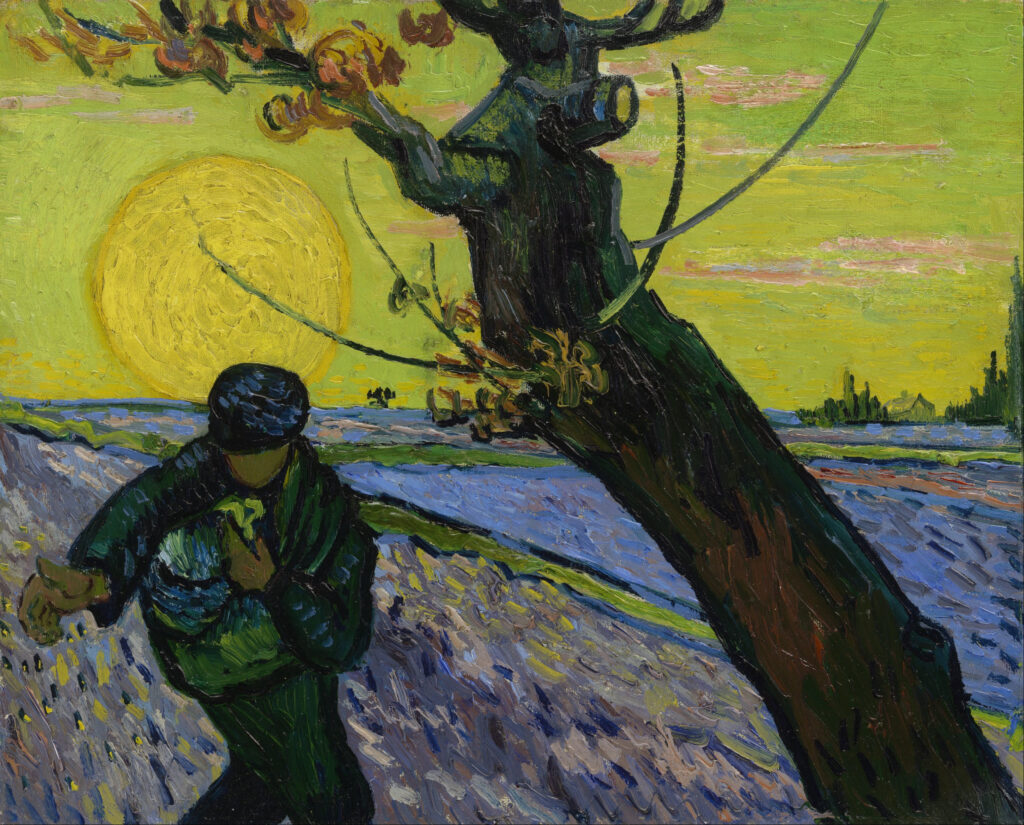
By Rev’d Canon Ian Morter
On a number of occasions I have had the pleasure of visiting the Van Gogh Museum in Amsterdam. As its name implies it is dedicated to the works of Dutch painter Vincent van Gogh and his contemporaries. It’s on the Museumplein, a square rather like the area of South Kensington in London that has several great museums close by; the Stedelijk Museum, the Rijksmuseum, and the Concertgebouw, concert hall. Within the extensive collection of Van Gogh’s works is the following painting:
The Sower painted in November 1888 only just two years before Vincent’s untimely death.
Vincent made over 30 drawings and paintings on this biblical theme during his artistic career. This particular interpretation of the theme was during the time he was working with Paul Gauguin when they shared a garret in the Southern French town of Arles. Gauguin was encouraging Vincent to draw less from reality and more on his imagination. So here we have an example of how Vincent used colour to express his passion and emotions. We have the amazing hues of the sky in greenish-yellow and purple of the soil in the field. The bright yellow sun looks like a halo somehow suggesting the sanctity of the sower.
Those of you who know about the life of Van Gogh will know that he was the son of a Minister in the Dutch Reformed Church and that he himself started to study for ministry. Perhaps that is why the image of the sower was important in his artistic work. The sower could be either God himself scattering his Word of Life or the sower is the Minister spreading the Good News of the Gospel in the world.
Seeing this image made me reflect on Jesus’ Parable of The Sower in St Luke’s Gospel (8:4-15) Lent started on Wednesday this week and there is the tradition of giving something up – but actually I try to take the more positive response “what I might do extra this Lent.”
Well I am going to try to take more care how I listen. As my son pointed out to me, “We have two ears but only one mouth, therefore, we should listen twice as much as we speak!”
The Parable of the Sower tells us how to listen.
First we must listen so that something ‘goes in’. All of us have had the experience of talking to someone, when suddenly we realise that the person to whom we are speaking isn’t listening. They hear, but nothing is ‘going in’. So too the Word of God will not ‘go into’ our lives if we are always on the go. Endless rushing about makes our lives like a path trodden down and packed hard by hurrying feet. No seed can possibly find root in hard packed soil – it just will not grow. To listen to the Word of God we must make time to be still with God – it hard advice to follow but so very necessary in our busy lives if we want to hear God’s voice.
Secondly, we must consider and weigh carefully what we have heard.
It can be that we are enthralled by the eloquence of a preacher, and go back time and time again to hear more, and still we do not hear God’s word. The preacher just ‘tickles our ears’ with memorable introductions, anecdotes or illustrations but the essence of what is being said is lost on us. Listening and hearing of that kind, is like a seed that suddenly springs up in warm sunshine, but because it has no depth of soil its roots are shallow, it quickly withers away in the mid-day sun.
When we listen to the Word of God we must reach down within our minds, through the form and beautiful structure, down to the deep roots of what is the real content of the Scripture. We need to go to the heart of the Gospel ‘that God so loved the world that he gave his only son, that all who believe in him should not perish but have eternal life’. That as Jesus was nailed to the cross he prayed “Father for give them.” “That Christ died for us while we were yet sinners.” Any other listening apart from this is may well be misplaced.
And finally we need to listen in such a way, that we give what we hear space in our minds.
Little value is to be found in rushing into worship at the last minute from doing the washing up from the night before or rushing out from Church to reading the morning paper just purchased or delivered. Our minds in these cases are like plants surrounded by weeds. The Word of God may have been heard, but like a plant it can only grow if it is surrounded by space. We must clear the ground around the Word of God. We must listen in prepared spaces of quiet and contemplation to hear what God is saying.
So then take care how you listen. Take care that your week is not crammed with endless activity however seemingly useful or purposeful and necessary. By that overcrowding comes spiritual inertia, paralysis. Take care that cleaver and memorable anecdotes or even high-sounding religious phrases are not confused with the Christian Gospel. The Gospel tells of receiving through giving, life through death, victory through sacrifice. This is powerful and sometime difficult teaching to take on board. Take care not to cram devotional observances into an already cramped programme. The Word of God must have space. Lent gives us the opportunity to listen carefully to the Word of God and make a start on hearing what God is saying to us.